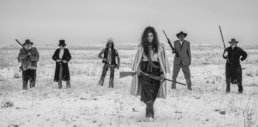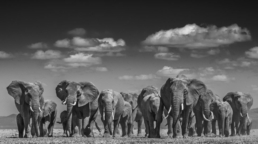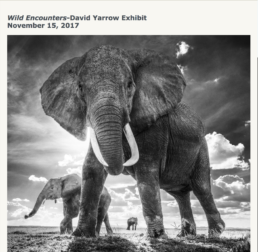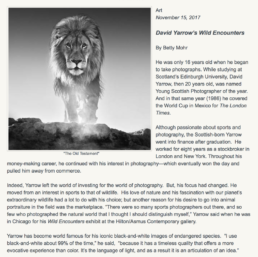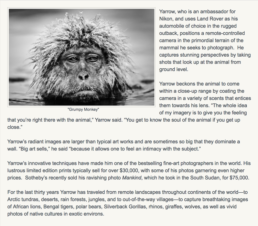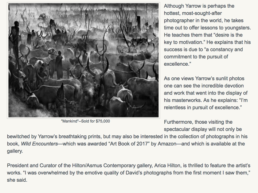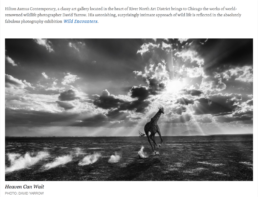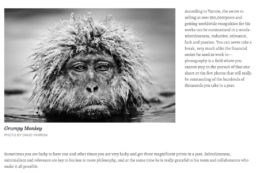Photographer David Yarrow on the Inspiration Behind His New ‘Wild West’ Series Starring Cindy Crawford and Cara Delevingne
Yarrow traveled to Montana and Wyoming to create these quintessentially American images.
British photographer and conservationist David Yarrow is celebrated for his black-and-white photos of far-flung territories, endangered landscapes, and nature’s most majestic creatures. This fall, after a long quarantine, the photographer set off for Wyoming and Montana to shoot his new series “The Wild West.” Headlined by supermodels Cindy Crawford and Cara Delevingne, the series captures quintessentially American scenes from the cross-country road trip, which culminated at a Western saloon. “The Wild West” series also features Chief John Spotted Tail, of the Lakota tribe, who appears self-styled in his images.
The new images—along with many of Yarrow’s iconic works from earlier series—are currently on view at Chicago’s Hilton | Asmus Contemporary. A portion of the profits from sales will be go to benefit charities and organizations supported by Yarrow and his models.
Below, Yarrow shares his inspiration behind a few of his new photographs:
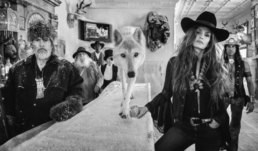
“We have all, at one time or another, entered a bar, and immediately felt out of place. At the most extreme level this can evoke a sense of trespassing. This was very much the narrative behind this photograph. To be greeted by an overtly territorial crew with menace and attitude. But, for the story to work, two things had to coalesce as—the characters and the interior. I like playing with the cold, it adds a visceral layer to the story and in this case, it hints at an outpost on the final frontier. Surely the further off the beaten track we travel, the greater the chance of being the outsider. This is a frame that exhausts every inch available in the camera and that was my intent. There were so many characters I wanted to include, but I was also reluctant to lose the mood of the frozen saloon…. Our key asset was, of course, Cindy Crawford, and she had to have sovereignty of the joint. She can play a badass very well and that was her ascribed role.”
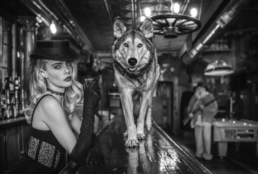
“The Pioneer bar in Virginia City has offered so much to us over the years and we are acutely conscious not to overplay our hand here. After all, there are many other weathered saloons in the West. We don’t want to be repetitive in our story telling…The Pioneer is emphatically the best bar known to us. It has depth and the wagon wheel on the ceiling is ideally positioned. To bring such a celebrated and relevant woman as Cara to Montana is fresh ground. Put her in front of the Eiffel Tower and it is a new look on the Eiffel Tower. I can’t think of any other woman in the world I would prefer to play this role. These are not easy images to execute as there is such limited light. Depth of field and shutter speeds are therefore compromised. Cara would always be sharp—that was easy—then we had to hope for some luck elsewhere. Cameras have improved so much over the years in terms of ability to work in low light. I could not have done this 10 years ago. But you are pushing the camera right to the edge of its capability.”

“Once we found the caterpillar road that dissects this picture, I knew that we had the canvas on which to continue our road series that started in 2018… The only traffic was the occasional oil worker or perhaps someone who was totally lost… The sense of place is palpable. This is the America that so many know and love, with its long roads running to the horizon with either side exuding a simple sense of calm and solitude. No other country in the world offers road trips as visually rewarding as America and they are integral to the fabric of the American dream. The snowfall the previous night added another layer to the narrative both on the road itself and on the prairies. We were lucky that the snow stopped and the light picked up. It adds warmth to an image already glowing with positivity and joy. Willie Nelson was surely singing “On the Road Again” on the car radio with the volume turned up to the maximum level.”
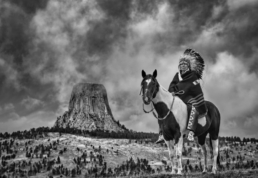
“The senior Elder of the fabled Lakota tribe is Chief John Spotted Tail. We spent two days with him in northern Wyoming and he was so excited to wear the headpiece that only the most senior Native American chiefs like him can wear. His attire was emphatically his decision, not ours. Their heritage is integral to their souls. The ground in front of Devils Tower has film history. It is, of course, where Spielberg shot Close Encounters of a Third Kind immediately after the release of Jaws in 1975. More poignantly, it is sacred land for Native Americans, and, at dawn, before our early morning shoot, John and his wife, Tamara Stands and Looks Back, spent some time there praying. At around 8:30 am, the low hanging clouds lifted above the iconic geographical landmark and shafts of light lit up our canvas. We had our moment. Later that day, when I showed Chief John Spotted Tail this image, he shed a tear and I am proud to admit I did too. It was one of the most privileged days I have ever had in the field.”
David Yarrow’s “The Wild West” series is on view at Hilton| Asmus Contemporary through June 2021.
Written By | Artnet
For Years, This Couple Has Been Quietly Collaborating on Sculptures. Now, They Are Finally Showing Together
The true extent of the collaboration between Boky Hackel-Ward and Blake Ward was a secret for years.
The story of husband-and-wife artists Blake Ward and Boky Hackel-Ward is a romance, certainly, but one complicated by the tribulations of the art market, among other obstacles.
They were born on different sides of the world: Ward in the depths of the Northwest Territories in Canada into a family that made its name running an airline and Hackel in Germany, who then was raised between Switzerland, Costa Rica, and Venezuela.
In a cinematic turn, the pair met at a wedding where he was the best man and she the maid of honor. There was a spark—but Hackel was married at the time and both were busy pursuing individual artistic careers.
Ward had studied figurative sculpture in Paris with the sculptor Cyril Heck and gone on to teach sculpture at the University of Hanoi, as one of the first Western educators in Vietnam since 1945. She was a Conceptual artist and polyglot who played in an orchestra and restored artworks for a living.
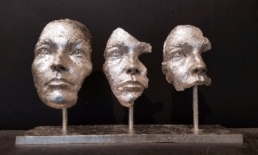
Three years later, the two would meet again, and, with Hackel newly single, they soon became a couple. But their union was more than romantic.
An artistic collaboration soon grew between them as Hackel slowly informed the development of Ward’s sculptures. Mutually thrilled by this development, the pair was unaware that their collaboration would actually cause a flurry of distress as Ward’s publicist at the time quickly tried to subdue news of Hackel’s involvement, believing it would damage his client’s career. For years, as later gallerists would continue to subtly dismiss her influence, Hackel continued to work quietly behind-the-scenes.
Now, for the first time, the couple will present both their own works and their collaborative efforts together in “Somewhere Within” at Chicago’s Hilton Asmus Contemporary. Recently, we caught up with the pair to learn more about their story and this collaborative debut.

How did you two begin to collaborate? Was it something you discussed or did it just happen?
Boky Hackel-Ward: Our collaboration happened quite naturally. I had been working in art restoration and at one point Blake asked me to help with some gold leafing on one of his sculptures. Before we knew it, I was learning about his process and helping him with wax casting, which can be rather temperamental with regards to temperature. We would enter this state of flow, where the world of the studio became the only world.
We went on foundry visits together, too. The first time I went, I just watched, but with my career history, working the bronze came quite naturally to me. Power tools and files didn’t intimidate me. Blake asked me for help, so I put some gloves on and the rest is history.
What was your work like before you started collaborating with Blake?
Boky: I composed music and wrote poetry and whenever possible did performance art pieces, such as conducting the university orchestra, complete with vocal cadenzas. I was strongly influenced by artists such as Laurie Anderson, John Cage, David Tudor, Merce Cunningham, and Robert Wilson.
One of my early sculpture pieces is Requiem for my Father, which is made of crushed wire and computer memory boards. I built things but it was a bit like swimming in the dark. I never really found the right medium until Blake walked into my life.
Blake, what qualities did you feel Boky contributed to your work?
Blake: When we were working in the foundry, she wasn’t concerned with the technical principles of the pour; she was fearless. I liked that energy. I watched her pour and copied her abandonment and found myself using the technique or, shall we say, the freedom with which she poured the wax.
She introduced the idea of deconstruction or, what we now call, the reverse engineering of our sculptures. She’s very good at editing the wax sculptures. I realized that these pieces were no longer just mine, they had changed and I wanted to include her in that.

When did you decide to start signing works together, to define yourselves as equal partners?
Blake: Boky made a sculpture called Hathor while I was away on a trip. When I saw it I recognized its significance: it’s a beautiful work that I couldn’t improve upon. Then, right away, I insisted she sign it. In my opinion, with that work, Boky had expanded upon the rules of classical sculpture and she had helped me to break some of those rules as well.
So her name is written on it in bronze. I thought that everyone would recognize and accept that she was a co-creator, but people didn’t. It seemed that everyone preferred to ignore the fact. I pushed back, since truly these people, particularly one marketing consultant, had no idea what she had contributed and were wrongly worried about my career.
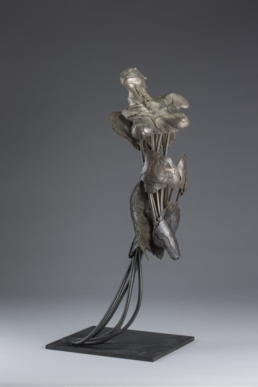
That must have been difficult for your relationship both as a couple and as collaborating artists.
Blake: These people missed the point completely. One of the things we try to do with this body of work is tell the truth; the truth in materials, the truth about the work, about how the work is made. This was another part of telling the truth. I was embarrassed by the way Boky was treated.
Boky: People insisted I’d ruin your career and I didn’t want to cause trouble for you. In this era, I suppose I expected some visibility as an individual artist. If nothing more, some credit for my work, for my ideas, and for my writing.
What changed?
Blake: We stepped back and removed these people from our lives. First I was shocked, then I was mad and then we became resilient. We retreated and let everybody’s contracts expire. It was a new chapter in both our careers.
Boky: Another very important element has been having a gallerist such as Arica Hilton who recognized us as a creative entity and wanted to show that to the world. She is an artist herself and an ardent defender of women.

How does it feel to be exhibiting together as an artistic entity for the first time?
Boky: The idea of being able to share our love story and our sculpture with others, and to do so openly, means everything to me. It means I’m not invisible. We all have our own stories and we all have the possibility of healing. For me this exhibition is about letting the light shine and telling the truth.
Blake: It is also about celebrating the overlooked accomplishments of Boky and all women, as well as recognizing realities facing our society today. Women still have to fight so hard for every little thing.
Written By | Artnet

